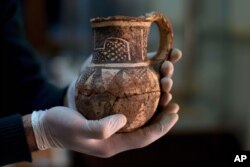A set of ancient Angkorian gold jewelry that found its way to a London art dealership will be returned to Cambodia after the government intervened to stop a planned sale.
The Jonathan Tucker Antonia Tozer Asian Art dealership listed the jewelry in its online catalog, according to a statement from Cambodia’s Ministry of Culture and Fine Arts.
The ministry petitioned the dealership in November to return the Angkorian artifacts. They originated in the Khmer empire, a power in Southeast Asia from A.D. 802 to A.D. 1431. At one point, it included much of today’s Cambodia, Thailand, Laos and southern Vietnam.
“Cambodia has provided concrete testimony to prove that the artifact jewelry belongs to Cambodia, is jewelry designed in the Khmer style and that only Cambodia has this style, and it was taken out of the country illegally,” the statement said.
Looting during the war
During decades of war, Cambodia lost countless priceless historical artifacts to looters and smugglers who targeted ancient sites. The Khmer Rouge and other military groups often controlled looters in their areas.
“There is a good argument that the illicit trade in artifacts, gemstones and timber even helped to prolong the conflict,” Terressa Davis, executive director of the Antiquities Coalition and School of Social and Political Sciences at the University of Glasgow, told VOA Khmer in an email.
Many of the items they took ended up with foreign art traders, although it is not clear when the jewelry in question was taken from the kingdom or by whom.
Jonathan Tucker, joint owner of the dealership, did not immediately respond to an interview request.
Items to return to Cambodia
The set includes a crown, necklace, earrings, armbands, belt and chest ornament, and will be returned with the assistance of the British government, Thai Norak Satya, spokesman for the Ministry of Culture and Fine Arts, said. In recent years, Cambodia has successfully repatriated several ancient statues from the United States.
Looting artifacts has a history almost as old as some of the items themselves.
The earliest known trial of looters in Egypt took place in Thebes in 1113 B.C. Today, there are curbs on the trade.
In 1970, UNESCO adopted the Convention on the Means of Prohibiting and Preventing the Illicit Import, Export and Transfer of Ownership of Cultural Property, which to date 132 countries have signed.
Antiquities in demand
Nonetheless, there is a multibillion-dollar demand for ancient artifacts such as the Angkorian jewelry — “too great a demand to be met by the legal supply,” Davis said.
“As a result, looting and trafficking is now an illegal industry that spans the globe, financing crime, conflict and even terrorism,” said Davis, a lawyer who in 2015 was knighted by the Royal Government of Cambodia for her work in recovering the country’s plundered heritage.
As is happening today in Iraq and Syria, “the Cambodian Civil War triggered organized looting, and trafficking, which helped to further bankroll the conflict,” she said.
Two years ago, UNESCO described the Islamic State’s looting in Syria and Iraq as “industrial” in scale.
Norak Satya said the recovery was “an act of encouragement” in the fight against the illicit trade in antiquities. Davis agreed, saying most Cambodian artworks are sacred objects that were never meant to be bought and sold.
“They are the rightful property — and legacy — of the Cambodian people,” she said. “Yet, like so many Cambodian families, the country’s ancient treasures were broken apart during the civil war and scattered to the ends of the Earth. As this story shows, they are continuing to surface and likely will for decades to come.”
Preserving heritage
Sambo Manara, a history professor at the Royal University of Phnom Penh, said the return of looted artifacts to Cambodia would help to preserve Khmer heritage.
“Our ancestors left us a heritage that the world started to pay attention to,” he said. “What we have obtained recently tells the world about the real value of Cambodia’s great men and ancient ancestors.”
Phoeung Sakona, Cambodia’s minister of Culture and Fine Arts, said the return of the artifacts would help to heal old wounds. She encouraged other dealerships to follow suit.
“It is a sign of Cambodia’s recovery that this heritage is now returning home, thanks to the hard work of the Ministry of Culture and Council of Ministers,” Davis said. “This is not just about art, it is about justice, and it gives hope to countries in conflict today, like Iraq and Syria.”








